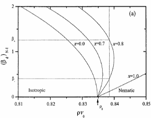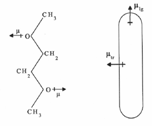Hydrogen bonding and phase biaxiality in nematic rod-plate mixtures
A. G. Vanakaras, S. C. McGrother, G. Jackson and D. J. Photinos, Molec.Cryst. Liq. Cryst., 323, 199 (1998).
Abstract: The possibility of using H-bonding interactions to promote the stabilization of phase biaxiality in nematic binary mixts. of oblate and prolate thermotropic mesogens is discussed. Onsager’s theory of the isotropic-nematic transition was extended to allow for such selective assocns. among unlike species and it is used to calc. the phase diagram of binary mixts. consisting of hard spherocylinders and cut spheres. Directional, short-ranged attractions between rods and disks strongly stabilize the biaxial nematic mixt. against demixing and suggest that interactions of H-bonding type may provide an efficient mechanism for sustaining phase biaxiality in binary mixts. of real thermotropic nematogens. Preliminary Monte Carlo simulations designed to test such predictions are discussed.


